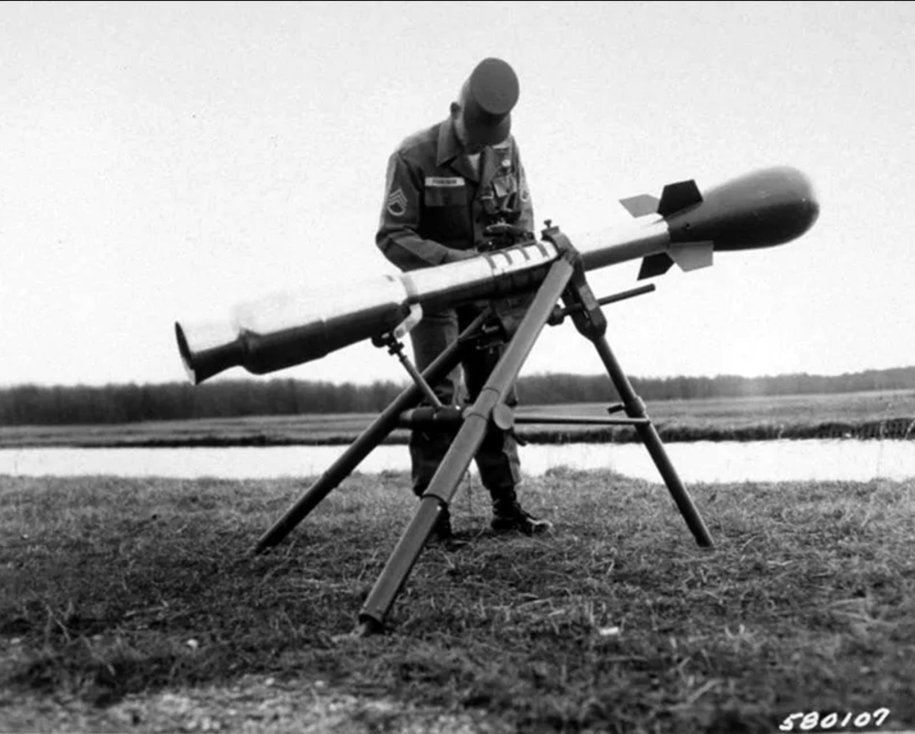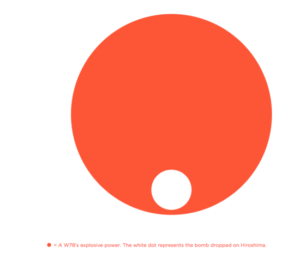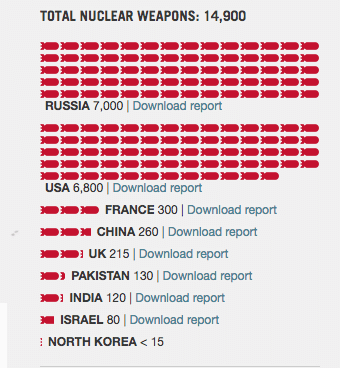Trump Regime on the Verge of Okaying Two New Warheads That Could Make Nuclear War More Likely
WEAPONS OF MASS DESTRUCTION, 22 Jan 2018
Timothy Lange | Daily Kos – TRANSCEND Media Service

This M28 “mini-nuke”—named the Davy Crockett—was first tested in 1962. It produced a yield of just 15 to 20 tons of TNT, 1000 times less powerful than the Hiroshima bomb, but also a big dose of lethal radiation.
16 Jan 2018 – As has been reported since last summer, the Trump regime seeks to build two new nuclear weapons, one of which—a low-yield warhead for submarine-launched ballistic missiles—could make nuclear war more likely, say critics. The other warhead would be developed to be carried by submarine-launched cruise missiles, which haven’t been equipped with nukes since 2010.
Developing and building these new nukes are elements included in the not-yet-finalized 2018 Nuclear Posture Review. The last NPR was released in 2010. If approved by Pr*sident Trump, a move which is expected later this month, it would mark a significant change from the Obama era when the emphasis on nukes as part of U.S. strategy was reduced.

That white dot shows the Hiroshima blast, and the red surrounding it is the explosive power of the W78 workhorse bomb that is currently fitted on 149 of the 399 land-based U.S. ICBMS. The Union of Concerned Scientists that created the image note that the W78 has a yield of at least 335 kilotons; Hiroshima was 14-15kt. In addition to the ICBMs, the U.S. has hundreds of missiles equipped with the W76 warhead at 100 kilotons, and the W88 at 475kt (31 times as powerful as the Hiroshima bomb).
Advocates of installing the lower-yield warhead on the submarine-launched Trident ballistic missile say it is a good thing specifically because it would mean the warhead would be more usable. Currently they complain, there is reluctance to actually launch any nuclear-tipped missiles because their yields make them so incredibly destructive. In other words, having a lower-yield weapon at hand would make it easier to “push the button.”
The draft NPR has trickled into the news since September when Bryan Bender first wrote about it at Politico. On Thursday, Ashley Feinberg took up the matter at The Huffington Post, posting a lengthy analysis of what the Pentagon calls a “pre-decisional” draft of the NPR along with a complete copy of it. On Monday, Michael R. Gordon at The Wall Street Journal reported from behind a paywall on the subject:
Supporters of the Pentagon’s plan say it is time for the U.S. to update its nuclear forces to deal with changing threats some three decades after the end of the Cold War. Critics worry that the Pentagon’s search for more flexible nuclear options could lower the threshold for their use.

The majority of the Russian and U.S. nuclear arsenals are held in “active reserve” and would take considerable time to bring back to operational status. But together, they have about 3,500 nuclear warheads actively deployed and ready for action in minutes.
One of those many critics told Bender:
“If the U.S. moves now to develop a new nuclear weapon, it will send exactly the wrong signal at a time when international efforts to discourage the spread of nuclear weapons are under severe challenge,” said Steven Andreasen, a State Department official in the administrations of Ronald Reagan and George H.W. Bush who served as the director of arms control on the National Security Council in the Clinton administration. “If the world’s greatest conventional and nuclear military power decides it cannot defend itself without new nuclear weapons, we will undermine our ability to prevent other nations from developing or enhancing their own nuclear capabilities and we will further deepen the divisions between the U.S. and other responsible countries
The Journal again:
A major concern for the Pentagon is a new Russian ground-launched cruise missile that American officials say violates the treaty banning intermediate-range missiles based on land, which was signed in 1987 by President Ronald Reagan and Mikhail S. Gorbachev, leader of the then-Soviet Union. Russia’s decision to develop and deploy that system is described by the review as part of a Russian doctrine that calls for threatening the limited use of nuclear weapons, or perhaps even carrying out a limited nuclear strike, to end a conventional war on terms favorable to the Kremlin.
By developing a new American “low yield” system, the Pentagon review argues the U.S. will have more credible options to respond to Russian threats without using more powerful strategic nuclear weapons, which the Kremlin may calculate Washington would be reluctant to use for fear of unleashing an all-out nuclear war. Because the new weapons it is proposing would be based at sea, the U.S. wouldn’t need the permission of other nations to deploy them and their deployment wouldn’t violate existing arms-control agreements.
It’s not hard to imagine that if the U.S. develops the new low-yield warhead, so will the Russians, and possibly the Chinese. If the U.S. were to launch one or a handful of such nukes against a Russian hard target—say a ballistic missile submarine base—a Kremlin response in kind could be expected. And once the little nukes start flying, nothing would stop the big ones from soon following. Next thing you know, the world’s survivors are acting out the script from The Road in real life.
The 890 nuclear warheads currently deployed on U.S. submarines each have a yield of 7 to 31 times more power than the one dropped on Hiroshima in 1945. Exactly what “low-yield” would mean is not yet defined. Trident missiles currently carry the city-busting W76 warhead at 100 kilotons (seven times more powerful than the 4-15 kiloton Hiroshima bomb) or the W88 at 475kt (31 times as powerful as the Hiroshima bomb). The new nuke would likely be in the 1kt-2kt range.
Although the actual toll will never be known for certain, the Hiroshima bomb killed around 80,000 people in a flash and at least another 100,000 from wounds and radiation-related sicknesses over the next 60 years. The fatalities from the bomb that took out Nagasaki were about half as many.
The horror of this alone gives pause to anyone except for the Dr. Strangeloves among us. However, decision-makers might be more willing to launch a nuke that yields, say, 10 percent of the Hiroshima bomb for use against a hard target such as, for instance, a deep underground weapons-manufacturing site in North Korea.
In other words, advocacy for building new mini-nukes is accompanied by a doctrinal shift that makes a mini-nuclear war “thinkable.” The main trouble with such thinking? Once such a war starts, keeping it mini by confining it to the delivery of a few small nukes—or solely to the nation that’s been hit with them—may well be impossible. Delivering two or three of these to North Korea might very well spur the Chinese to respond with some bombs from their own nuclear arsenal. Nuclear calculus is a dicey game.
The idea of building low-yield nukes is hardly new. Before the major global reduction of nuclear warheads that began in the late 1960s, the U.S. had thousands of such mini-nukes in its inventory—artillery shells, landmines, depth charges, torpedoes, short-range ballistic missiles, even a kind of bazooka.
It still has many nukes in the form of gravity bombs meant to be dropped from airplanes and warheads atop submarine-launched ballistic missiles and air-launched cruise missiles that can be instantly configured for low yields. Of a total active deployment of 1,740 bombs and warheads, the United States has several hundred with in-flight “dial-up” capabilities. This allows for variable yields as low as 0.3 kilotons of TNT (1/50th the yield of the Hiroshima bomb) and as high as 340 kilotons.
At few months ago, James Doyle at the Bulletin of the Atomic Scientists wrote:
In December [2016], the Defense Science Board—an independent group of experts and former officials that provides advice to the Defense Department—submitted a report advising the Pentagon to invest in low-yield nuclear weapons that could provide “a rapid, tailored nuclear option for limited use.” This recommendation struck a familiar note.
In 2003, the board issued a study entitled “Future Strategic Strike Forces” that suggested building small nuclear weapons with “great precision, deep penetration, [and] greatly reduced” yield and radioactivity. The board’s call led to investments in new warhead designs such as the Robust Nuclear Earth Penetrator—a warhead designed to destroy deeply buried or hardened targets including underground military command centers—and the Reliable Replacement Warhead. Both programs were cancelled in 2008, after millions of dollars had been spent.
Despite the board’s renewed interest in smaller nuclear weapons, and in weapons tailored for limited uses or specific effects, any effort to develop these weapons would encounter the same problem that earlier such efforts have encountered: It is impossible to determine if introducing weapons with these characteristics into the US stockpile, and planning for their use in certain scenarios, would strengthen deterrence or make nuclear war by miscalculation more likely. Building “mini” or tailored nuclear weapons might well lower the threshold to nuclear war; risking that outcome would only make sense if it were absolutely clear that introducing these weapons would remedy some dangerous weakness in deterrence.
Fortunately, no such weakness exists. Any nation using nuclear weapons against the United States or its allies risks a devastating response whose negative consequences would far outweigh any gains delivered by crossing the nuclear threshold.
One key aspect of mini-nukes is their potential for use as first-strike weapons in internationally prohibited “preventive wars” that the Bush Doctrine posited. For instance, striking suspected or actual nuclear facilities in Iran or chemical weapons operations in Libya was one of the rationales for promoting development of low-yield nukes in the early 2000s. Such attacks might not develop into all-out war when directed against non-nuclear nations. But there are no guarantees and the potential for guessing wrong in this matter is enormous.
Doyle continues:
Just as in the early 2000s, current proponents of mini-nukes or of vague “limited nuclear options” offer no convincing evidence that new weapons in this category are needed—or more importantly, that they would make nuclear use less likely. Instead, potential nuclear adversaries are likely to see the acquisition of additional weapons in this category as an indication that US opposition to nuclear use has decreased and that Washington may be the first to cross the nuclear threshold. Such an outcome would undermine global stability and increase the risk of nuclear war. Defense resources are better spent on strengthening US conventional forces.
And here’s Bender again:
“It is difficult to imagine the circumstances under which we would need a military option in between our formidable conventional capabilities and our current low-yield nuclear weapons capabilities,” added Alexandra Bell, a former State Department arms control official. “Lawmakers should be very wary of any attempt to reduce the threshold for nuclear use. There is no such thing as a minor nuclear war.”
There is a much-ignored part of the Nuclear Non-Proliferation Treaty—Article VI:
Each of the Parties to the Treaty undertakes to pursue negotiations in good faith on effective measures relating to cessation of the nuclear arms race at an early date and to nuclear disarmament, and on a treaty on general and complete disarmament under strict and effective international control.
That should be item No. 1 on the minds of the drafters of the latest Nuclear Posture Review, not the development and building of more nuclear weapons.
Ronald Reagan didn’t have the right idea about a lot of things. But he was right in pursuing “a world free of nuclear weapons,” which he considered to be “totally irrational, totally inhumane, good for nothing but killing, possibly destructive of life on earth and civilization.” He and Soviet leader Mikhail Gorbachev put that vision on a path to reality with their disarmament negotiations. Barack Obama also wanted a world with zero nuclear weapons. Less than three months into his first term of office, he said in Prague:
Some argue that the spread of these weapons cannot be stopped, cannot be checked — that we are destined to live in a world where more nations and more people possess the ultimate tools of destruction. Such fatalism is a deadly adversary, for if we believe that the spread of nuclear weapons is inevitable, then in some way we are admitting to ourselves that the use of nuclear weapons is inevitable.
Just as we stood for freedom in the 20th century, we must stand together for the right of people everywhere to live free from fear in the 21st century. And as nuclear power — as a nuclear power, as the only nuclear power to have used a nuclear weapon, the United States has a moral responsibility to act. We cannot succeed in this endeavor alone, but we can lead it, we can start it.
So today, I state clearly and with conviction America’s commitment to seek the peace and security of a world without nuclear weapons. I’m not naive. This goal will not be reached quickly — perhaps not in my lifetime. It will take patience and persistence. But now we, too, must ignore the voices who tell us that the world cannot change. We have to insist, “Yes, we can.”
It’s true that most of the specific moves President Obama outlined in Prague toward global zero for nukes haven’t borne any fruit. But that doesn’t make his or President Reagan’s push in the no-nukes direction pollyanna-ish or in any other way wrongheaded. The last thing the man now in the White House should be doing is endorsing the building of more nuclear weapons based on the views of people who think deploying and using some small nukes would be valuable to U.S. security. But if it adds to his fantasies about raining fire and fury on North Korea, he no doubt will adopt this recommendation to the detriment of us all.
DISCLAIMER: The statements, views and opinions expressed in pieces republished here are solely those of the authors and do not necessarily represent those of TMS. In accordance with title 17 U.S.C. section 107, this material is distributed without profit to those who have expressed a prior interest in receiving the included information for research and educational purposes. TMS has no affiliation whatsoever with the originator of this article nor is TMS endorsed or sponsored by the originator. “GO TO ORIGINAL” links are provided as a convenience to our readers and allow for verification of authenticity. However, as originating pages are often updated by their originating host sites, the versions posted may not match the versions our readers view when clicking the “GO TO ORIGINAL” links. This site contains copyrighted material the use of which has not always been specifically authorized by the copyright owner. We are making such material available in our efforts to advance understanding of environmental, political, human rights, economic, democracy, scientific, and social justice issues, etc. We believe this constitutes a ‘fair use’ of any such copyrighted material as provided for in section 107 of the US Copyright Law. In accordance with Title 17 U.S.C. Section 107, the material on this site is distributed without profit to those who have expressed a prior interest in receiving the included information for research and educational purposes. For more information go to: http://www.law.cornell.edu/uscode/17/107.shtml. If you wish to use copyrighted material from this site for purposes of your own that go beyond ‘fair use’, you must obtain permission from the copyright owner.
Read more
Click here to go to the current weekly digest or pick another article:
WEAPONS OF MASS DESTRUCTION: